Word-of-mouth referrals are powerful.
Recommendations from your friends and family are the most trusted form of advertising.
In fact, Nielsen found that 92% of people trust referrals from their network over television and online ads. Word-of-mouth referrals also contribute to 50% of most purchasing decisions. These numbers show that word-of-mouth must be a part of your marketing arsenal.
Fortunately, modern-day technology and tools enable businesses to build and market a referral program within minutes. As a result, brand advocates can instantly promote your business in droves. Since referrals are a trusted form of advertising, it’s also likely that these promotions will turn into sales.
Now, how can you launch your referral program? In this piece, we’re breaking down the 5 steps you need to take to build and market a referral program of your own:
- Step #1: Choose referral incentives
- Step #2: Do the math
- Step #3: Launch a referral program
- Step #4: Promote your referral program
- Step #5: Get people to (socially) share your product
Let’s get started! 😃
Step #1: Decide on your referral offer
Incentives distinguish referral programs from other forms of marketing strategies.
Customers who act as brand advocates receive freebies, discounts and exclusive offers in exchange for a successful referral.
That’s exactly why the first part of building a referral program is deciding what you’ll reward customers who share your products. People want to get rewards – big or small – in exchange for customer loyalty.
In fact, a Wharton School of Business study found that 83% of satisfied customers are open to referring products. However, only 29% end up actually doing it. By giving your existing customers a nudge—and a reward—you can speed up the referral process and get their network to know much they love your products.
For example, Thrive Causemetics offers vegan and cruelty free products to consumers. Their refer-a-friend program rewards advocates and their referred friends with $10 off. For every product purchased, they also donate to causes such as domestic abuse, cancer and
homelessness.

Cash rewards or discounts are some of the easiest rewards to distribute en masse—but they’re not the only options. Think outside the box and brainstorm incentives that are useful to customers.
- Which incentives will encourage them to share your product or service with others?
- What do they actually want from your product?
- Can you satisfy brand advocates with upgrades and exclusive offers?
Let’s look at a real-life example—Tesla.
The brand’s referral program offers 1,000 miles of free Supercharging in exchange for encouraging their friends to buy a car, which can save customers a lot of money. You also get the chance to win a Model Y monthly or Roadster supercar quarterly.
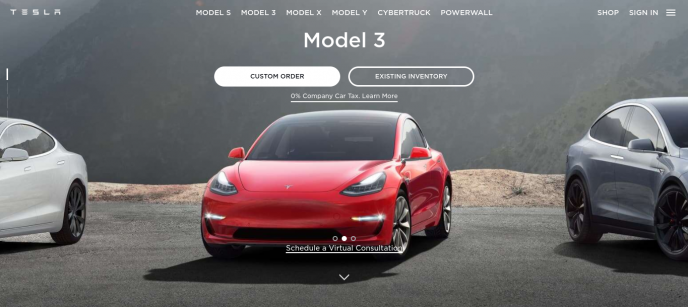
Not only does the program give customers a chance to win a new Tesla car, but it also offers something they want more than cash. The goal is to consider what your customers really want in return for recommending your product to others.
Once you’ve decided on an offer, it’s time to crunch the numbers.
Step #2: Do the math
Time to do a little math.
Once you’ve decided on a referral reward, calculate whether or not implementing it will bring in—or cost you—money.
The first is to determine the cost vs revenue.
Write down the cost of your referral program (i.e. expense of your referral reward) and then estimate how much you think the program will bring in sales-wise. If you have launched a referral program before, you can use the past data to estimate expenses or profits. Otherwise, you’ll need to make a rough estimation by looking at cost per acquisition.
In general, referral rewards should cost around 10% to 20% of the value of your product so your business will stay afloat in spite of distributing them en masse.
Here are additional elements to consider:
Minimum purchase amounts
Add a minimum purchase amount to ensure that you’ll get something in return in exchange for the freebie or cash. You may offer a free welcome gift, but only if they spend a certain amount.
For example, The Clymb – an online store for outdoor gear – gives brand advocates $15 credit if their friends make the first purchase. However, the minimum purchase amount must be at least $50.
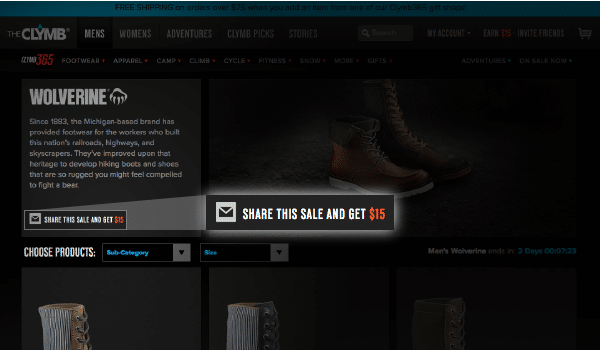
Referral review period
What if the referred friend makes a purchase but returns the product? Review the transaction and modify your to Terms & Conditions to ensure rewards will only be distributed when a purchase has been made.
Limited number of referrals
While some bigger companies like Uber have unlimited referral rewards for their customers, other businesses don’t have the cash flow to maintain these luxuries in the long-term.
Exclusive offers for limited-edition products may be distributed on a first come, first serve basis or until stocks last. The time limit may encourage brand advocates to act as soon as possible.
A good tip is to monitor the impact of your referral program in your sales and profits to ensure that you will breakeven.
Step #3: Build out your referral program
Building a referral program from scratch involves a lot of trial and error.
The Airbnb team spent 90 days writing 30,000 lines of code just to get their Referrals 2.0 system up and running.

Morning Brew’s referral program was also built from the ground up by developers stream Ruby on Rails. The program took a long time to develop because the company’s developers had to create unique referral codes, links, a double opt-in process and API requests, according to the company’s Senior Product Lead, Tyler Denk.
While the program was a success, the program took a long time to get off the ground.

Fortunately, apps like ReferralCandy allow businesses to create a referral program within minutes. You can specify the referral rewards and the platform will handle sending referral codes and handling the entire referral process for all parties involved.
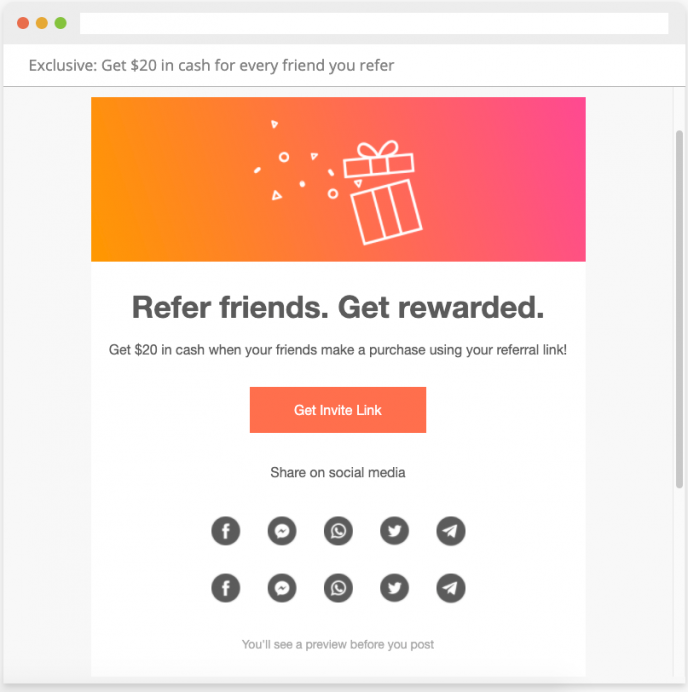
Step #4: Invite existing customers to join your referral program
As soon as you’ve launched a referral program, test the waters with your existing customers.
A common way to start this off is by promoting your referral program in your website, landing pages and emails. The key is to make a clear copy highlighting your referral reward and process.
ZooSho’s referral program uses the slogan, “Give $10, Get $10″ and a three-step process for making a referral. This allows viewers to easily understand what they can expect from the program and how they can get started.

Another tip is to promote your program through a referral email. You can briefly mention your referral program at the bottom of your promotional emails. Alternatively, you can even invite customers to join your program through a post-purchase transactional email.
Casper – a mattress retailer – mentions their referral program at the bottom of their promotional emails.
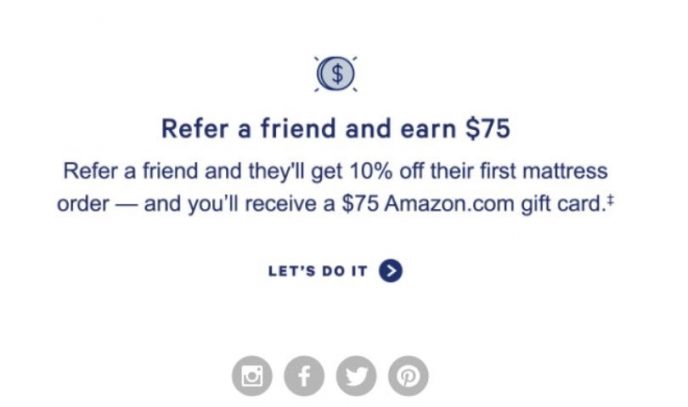
You can also consider using chatbot technology to inform your existing customers about the referral program you run. Just choose the best chatbot platform for your business’ needs and send your bot to promote your referral program to past customers.
Step #5: Get people (socially) shouting about your product
Finally, get your brand advocates to share your product via word-of-mouth through their social media accounts.
Boost referral membership by enabling customers to share them socially. You can add social media icons at the bottom of your referral message to spread the word and share the referral program link. This means more chances of your program being successful.
Plus, when sharing a referral link, customers are probably going to say something nice about your brand, which can lead to a 28% higher engagement level compared to when a company is promoting itself.
For example, Peloton – a retailer of workout equipment – launched a referral program that lets customers $100 off shoes and accessories. Since brand advocates want their friends to access this perk, they share their positive customer experience and their referral link on social media.
Since a lot of friends have been asking me if we like our @onepeloton bike… yes we love it and it’s great to stay in shape right now. This link will score you $100 off some shoes or accessories when you buy the bike using my referral code: Q4YGSE https://t.co/hCbLbCRQvi
— Peter Deltondo (@PeterDeltondo) April 19, 2020
Uber’s referral program lets customers receive cash credits when their friends use their referral code. The cash credit can be claimed on their next ride.
Referrals have been one of the main driver’s of Uber’s growth, netting them a 12x ROI. This is because it’s easy for customers to share their referral codes onto their social media accounts.
All they have to do is:
- Tap their menu
- Tap the “free rides” option
- Send invites
- Select what social media (or messaging) platform they want to use to distribute their unique code

Uber’s referral program proves that you don’t need an expensive reward to make your program super popular. Their current referral reward is a ride credit of $5, which is hardly a huge incentive. But the company made it so easy for people to give their friends and family a discount so customers can persuade their friends, without a ton of effort on their part.
Alternatively, you can even collaborate with influencers for product reviews or unboxing videos. Simply include a referral or affiliate link in the description. Influencers love to advertise referral links because they can get a bundle of rewards for influencing thousands of people.
For example, SaruGeneral – a BAPE and SUPREME supplier – collaborates with influencers like Harrison Nevel for the unboxing video of the brand’s $25,000 mystery box.
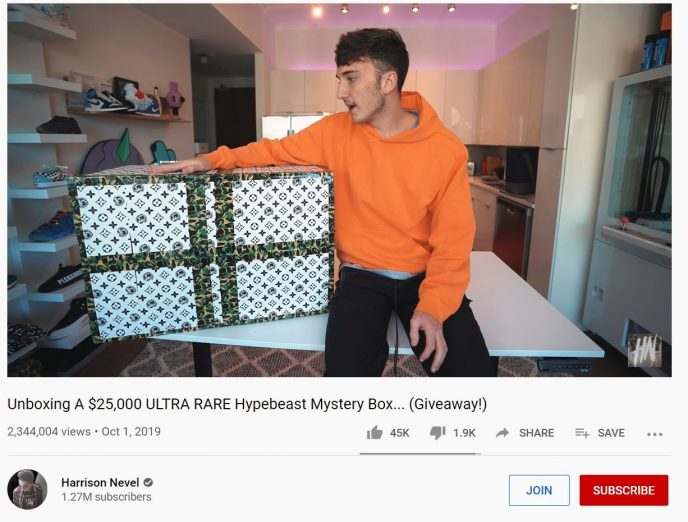
In the description, viewers can use his referral code Harrison10 to get 10% off their mystery boxes.

Now… It’s your turn to build and market a referral program
Referral marketing and word-of-mouth marketing aren’t new concepts.
We trust friends and family to give us the truthful and trustworthy recommendations. We trust them more than any other form of advertising. So, it makes sense that we seek their advice when trying new products. Unfortunately, you won’t expect a lot of referrals without giving rewards and incentives to your brand advocates.
And that’s where referral programs come into play. Not only do they let customers promote your programs, but they also reward them for doing so. Pretty soon, you can expect customer referrals in your local supermarket and on your social media too.
How to get started? ReferralCandy lets companies build their own program and facilitate the entire process. Their app even offers a 30-day free trial that lets you build and test your own referral program for your business.